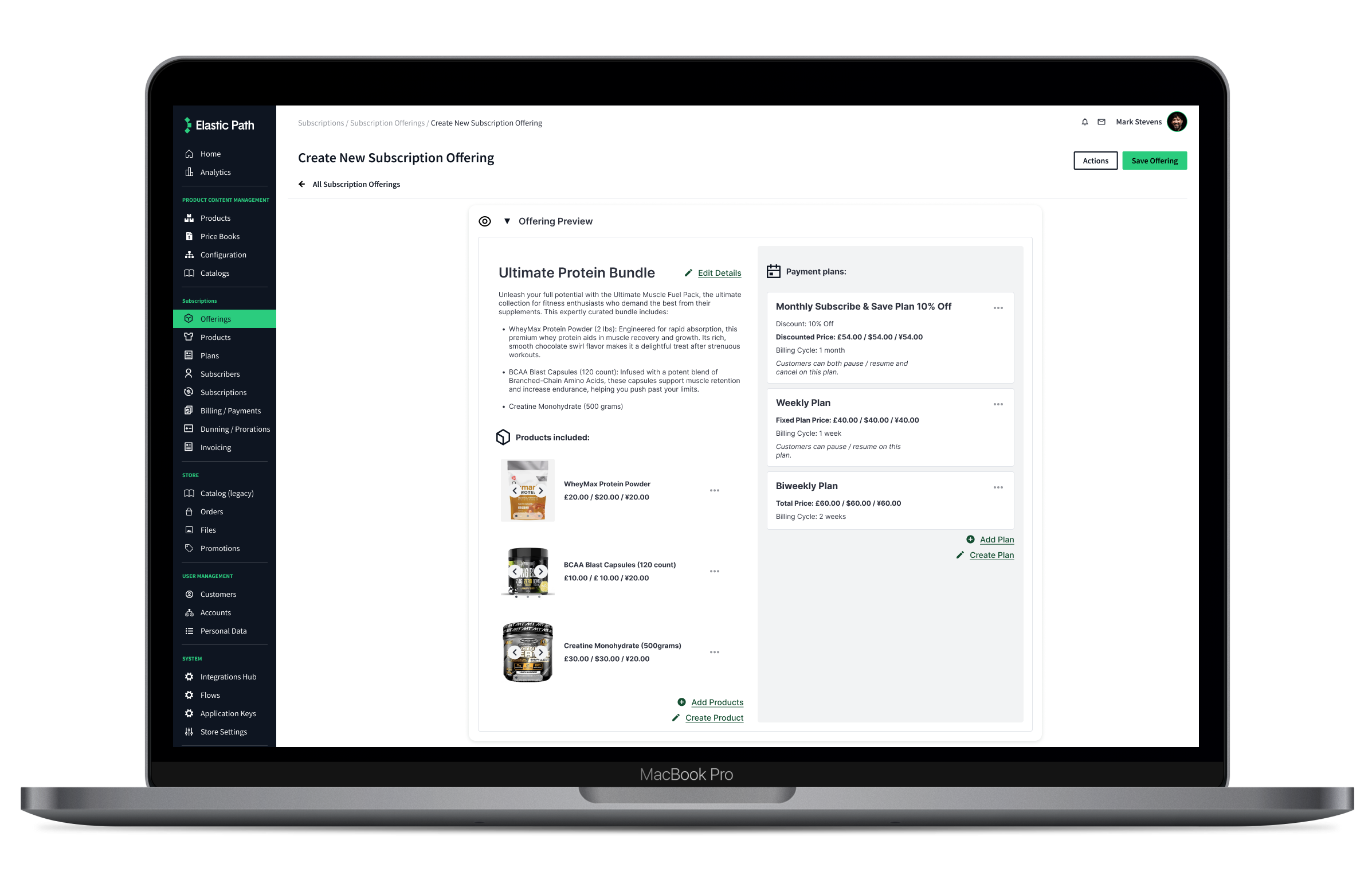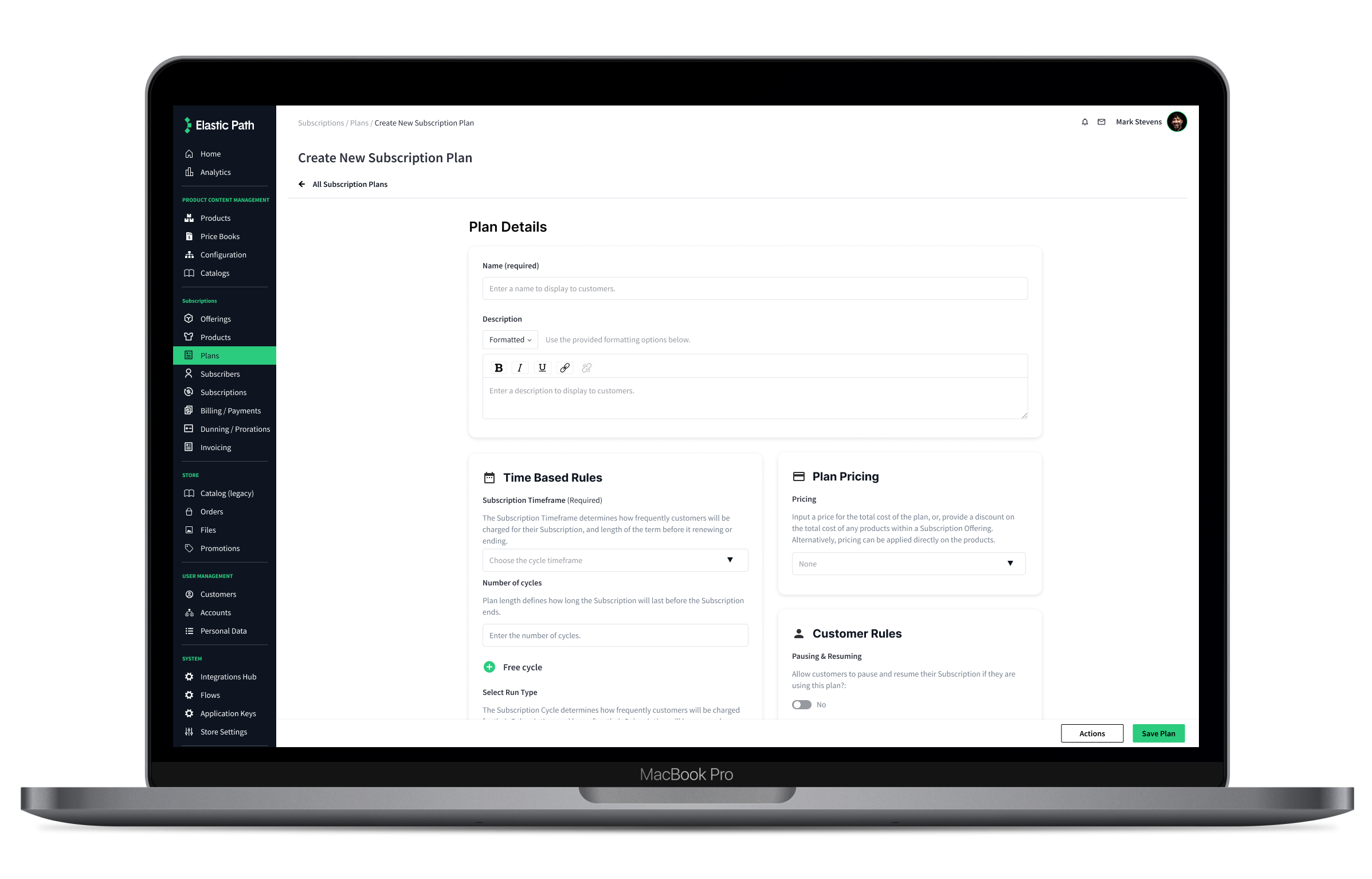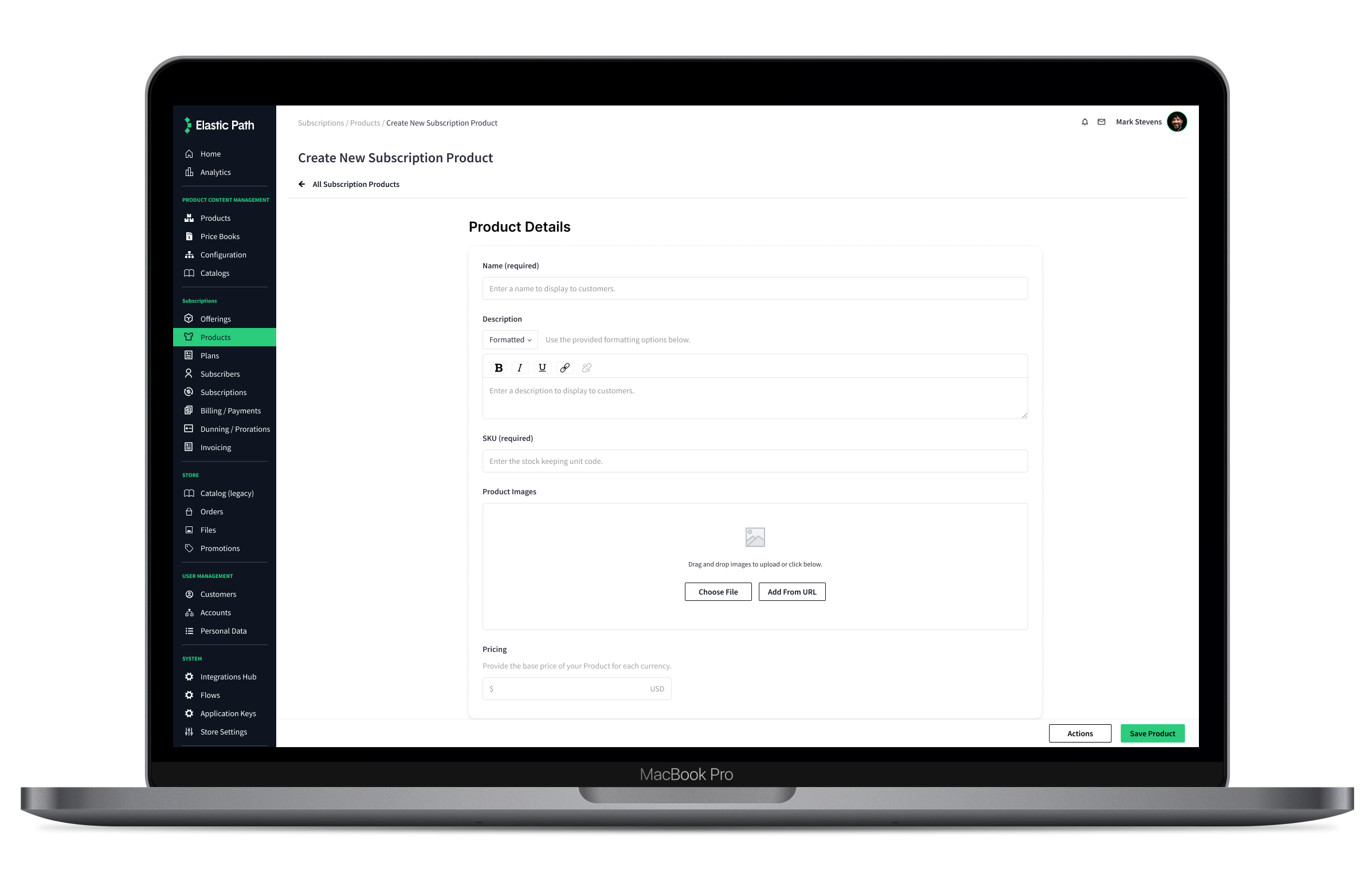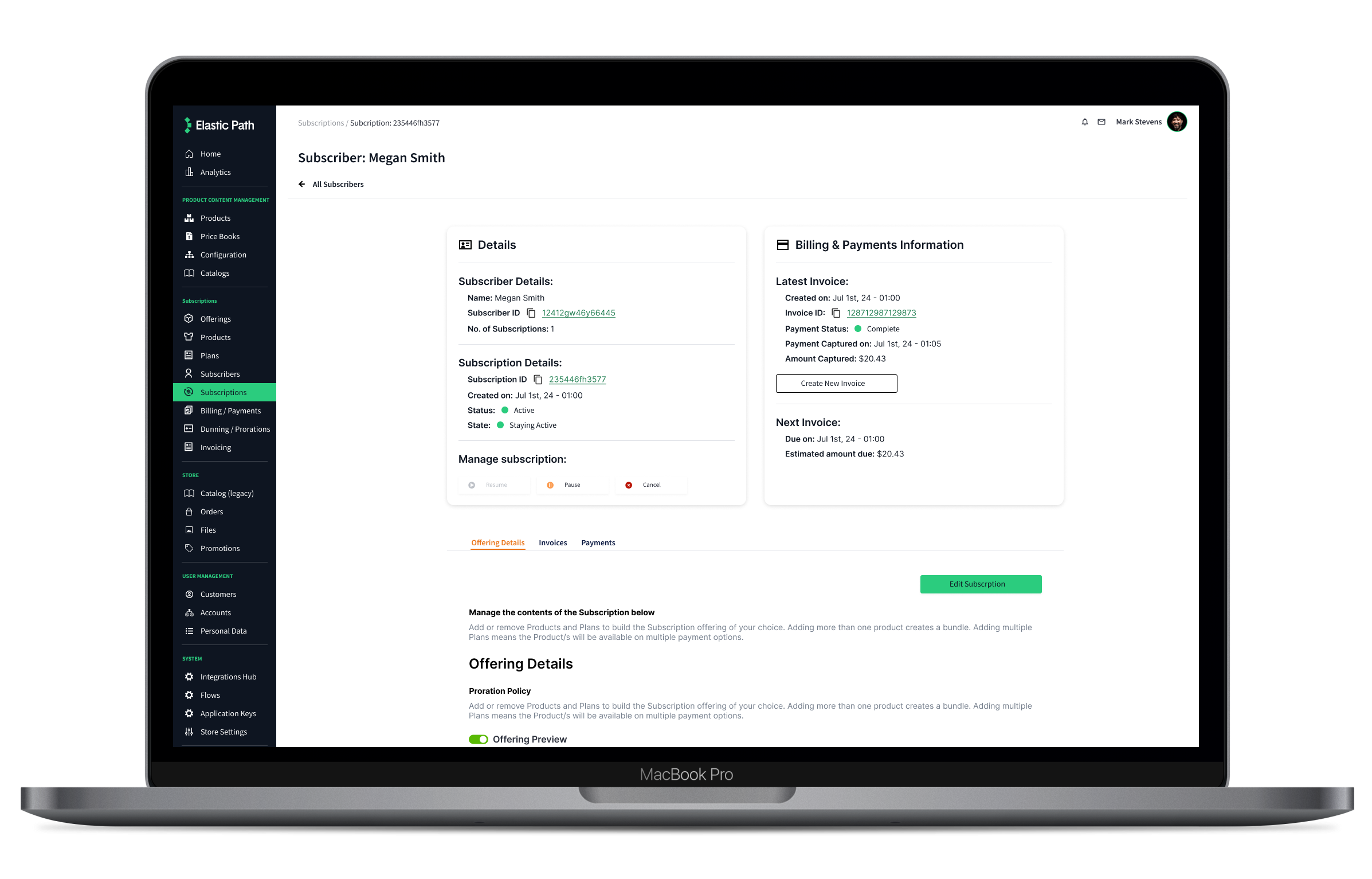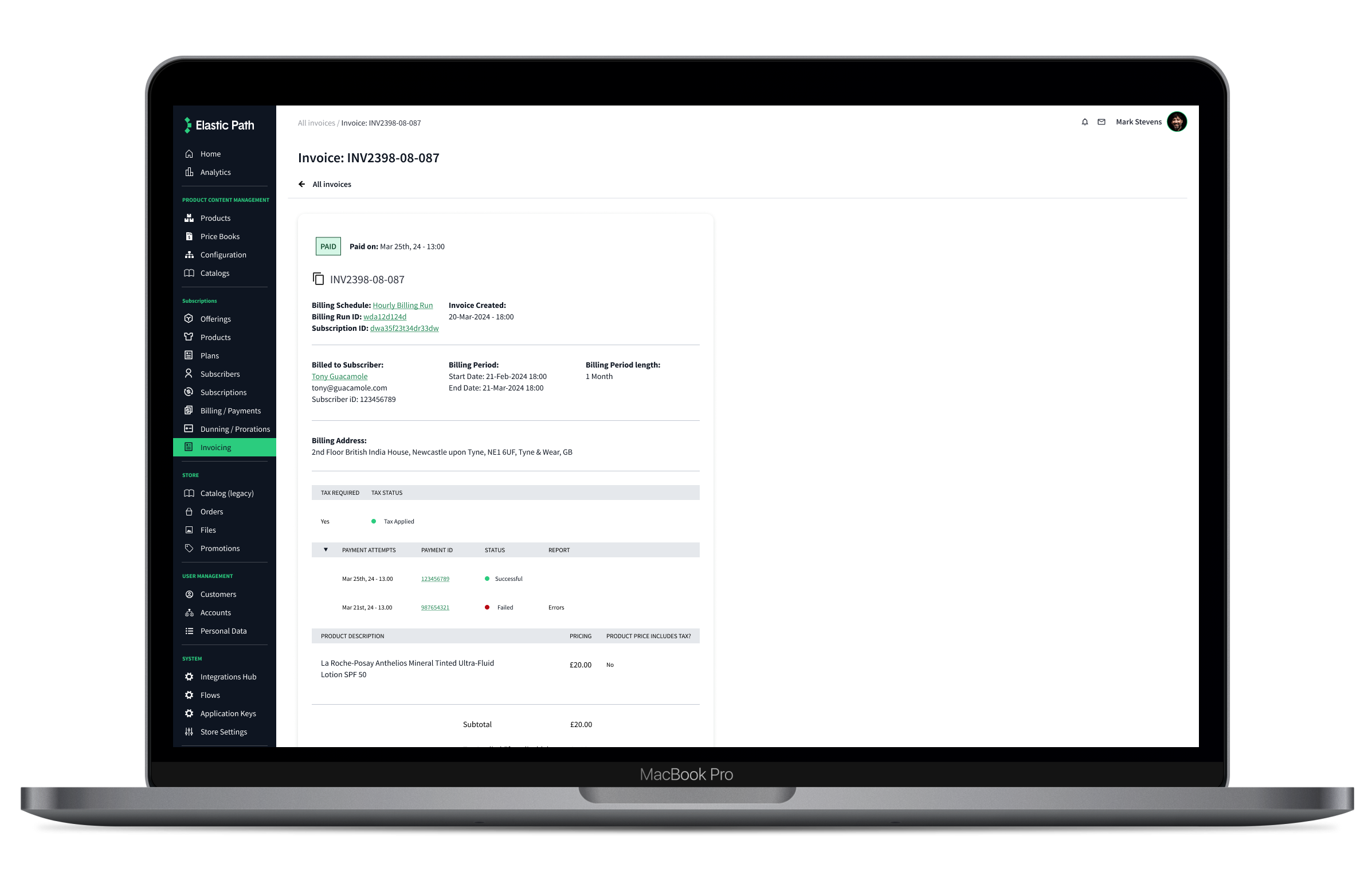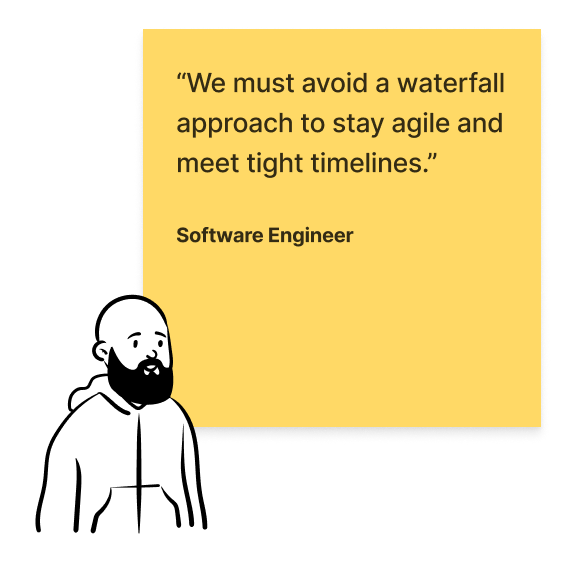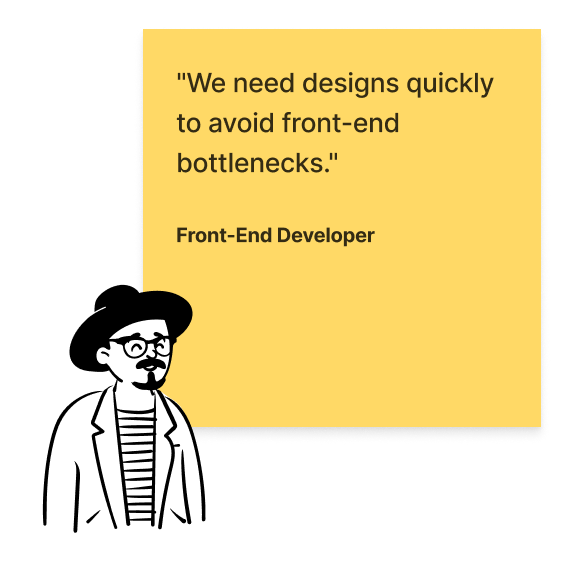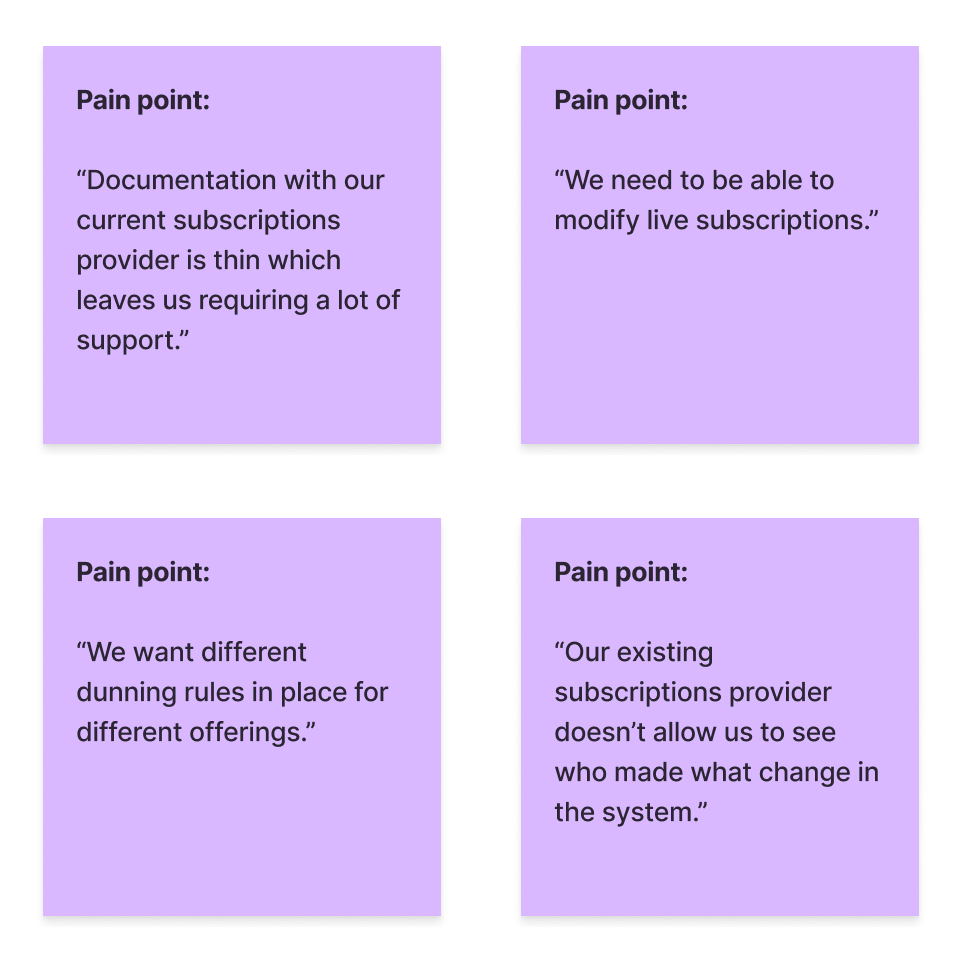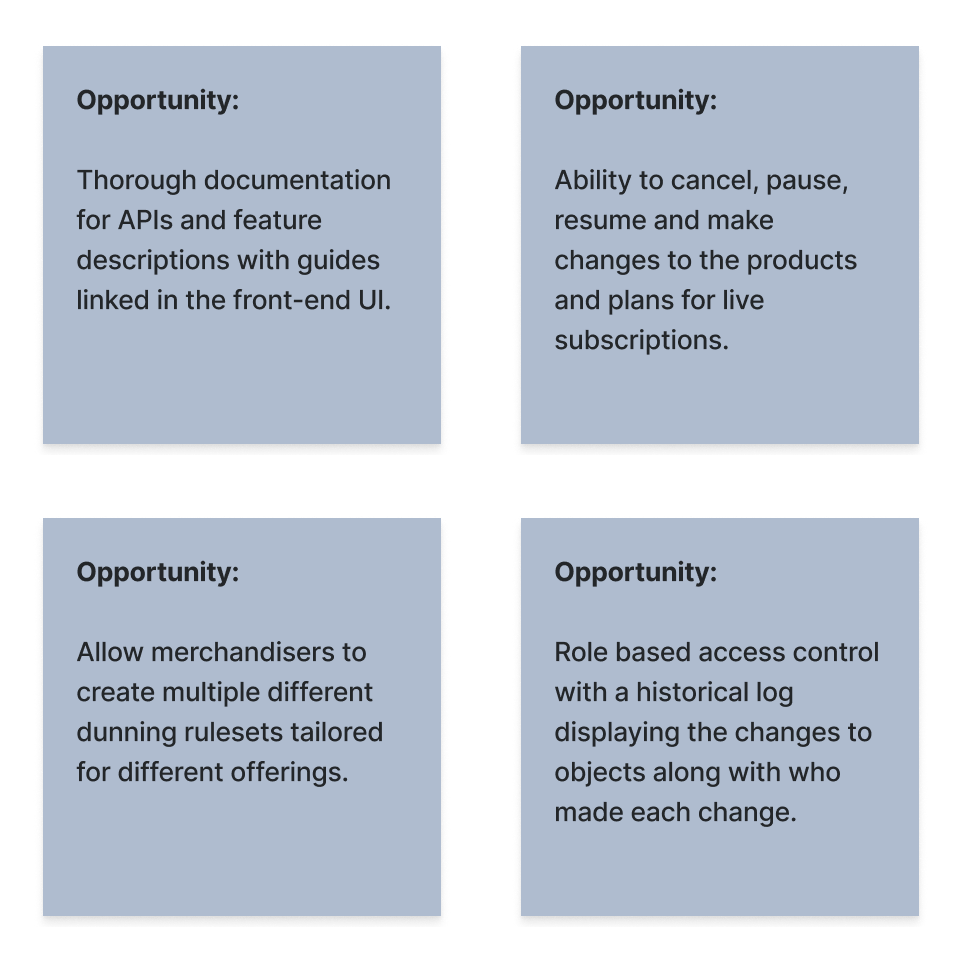Case study
Elastic Path Subscriptions
Elastic Path Subscriptions enables merchandisers to easily manage subscriptions, offering flexibility to pause, update, or reactivate plans, adjust billing cycles, and apply discounts to meet both business and customer needs.
Role:
Senior UX Designer
Employer:
Elastic Path
Platform:
Web app
Project length:
1 year, 4 months
01/Context
Backstory
Elastic Path, a B2B SaaS company providing ecommerce software for merchandisers, relied on a "land and expand" strategy with wedge products to drive adoption. However, the lack of a subscriptions service was a significant limitation. Long requested but deprioritised, subscriptions were finally reprioritised as essential. I joined a newly formed agile team as the sole designer to launch this key service.
Why it mattered
Subscriptions have grown 435% in the last decade, becoming a cornerstone for driving repeat purchases, boosting revenue, and fostering customer loyalty. Merchandisers increasingly need to offer both physical and digital products on subscription—whether for streaming platforms, memberships, mystery boxes, or household goods. Yet, Elastic Path couldn’t enable automatic repeat purchases for its customers, leaving a significant gap in its offerings. This missing functionality had become a competitive necessity, demanding immediate action to deliver a solution and maintain market relevance.
The subscriptions market: up 435% in a decade.
02/Challenges
Collaboration and agility under pressure
Tight deadlines required an agile approach to avoid bottlenecks and keep development adaptable. Delivering a quick proof of concept was critical, demanding rapid iteration, close collaboration, and fast design handovers to support front-end implementation. The team’s focus on staying flexible and aligned was key to overcoming these challenges.
Merchandisers can manage their offerings with ease by combining products and plans.
Influencing team strategy
As part of the product trio, I drove the strategy for the Subscriptions service, aligning UX and product goals in weekly meetings. I prioritised critical features—products, plans, and offerings—while deferring subscriber management to keep momentum. Making decisive UX calls, I cleared blockers, hit deadlines, and delivered a proof of concept for rapid customer testing and iteration.
Lean
I embraced a Lean UX approach, focusing on rapid feedback and iteration. I joined customer calls with the product manager to test designs and gather insights, used PostHog to track how employees interacted with the service, and presented prototypes and low-fidelity designs for quick team alignment. This process ensured we refined features efficiently and delivered what mattered most.
Tackling time constraints
2 week design sprint • rapid design • remote sessions • team alignment
With just two weeks to provide UX support alongside commitments to other initiatives, I initiated a focused design sprint to move rapidly from ideation to an MVP solution, complete with wireframes. To fast-track progress, I tapped into existing knowledge, including the product manager’s insights into key customers, and prioritised aligning the team around a clear, shared vision for the service. As a result of my impact, I was moved onto the service full time after the initial two weeks.
Persona mapping
Journey mapping
Service blueprinting
Wireframing
03/Empathising
Journey mapping: from pain points to opportunities
During the initial two-week design sprint, we mapped the subscription journey to uncover key insights. By capturing thoughts, pain points, and opportunities, we identified clear actions to tackle challenges and improve the user experience. This workshop shaped a focused, user-centred solution.
04/Process
Ensuring users can complete basic tasks
Ensuring users could seamlessly create subscription products, set up payment plans, manage invoices, control billing cycles, and amend live subscriptions was vital to the service's success. After the initial design sprint, I validated navigation and features by creating a sitemap and collaborating with engineers, the product manager, and the front-end developer to gather feedback and refine the structure.
Essential user workflows:
Creating products.
Creating plans.
Managing billing and payments.
Managing customers live subscriptions.
A sitemap I created as a way to collaborate with and validate the navigation with my team.
Exploring ideas using lo-fi designs.
Prototyping hi-fi designs.
An early-stage prototype showing how merchandisers can cycle through their subscription products and plans.
Delivering on feedback and iterating designs
Dogfooding • cohort beta testing • A/B testing
During the development of the service I led internal dogfooding sessions where Elastic Path employees tested the UI, UX and features in real-world scenarios. Working with an internal cohort, I refined the interface and functionality, ensuring clarity and usability. Partnering with the Product Manager, I gathered feedback from multiple customer calls, iterating the design from MVP to a polished, ‘simple, loveable, complete’ solution. One key focus was refining the subscription plan screen to enhance usability and meet user needs.
Subscription Plan screen MVP - Pre testing.
Subscription Plan screen SLC - Post beta launch.
Opportunities:
Refining copy, improved guidance for users, additional features.
Results:
Clear, comprehensive copy.
Documentation links for support.
Iconography for better navigation.
Grouped features into components.
Improved text formatting (HTML/non-HTML).
Added plan preview for clarity.
Plan length feature.
Free trial feature.
Auto-renewal feature.
Merchandisers can view and manage live subscriptions.
Merchandisers can configure billing and payment runs.
Facilitating and guiding my team to meaningful conclusions
During the 1 year and 4 months from conception to launch, I facilitated a range of targeted workshops to drive progress and clarity. These included story mapping, must-should-could-won’t (MoSCoW) prioritisation, and “how might we” ideation sessions. Each workshop was tailored to the specific stage of the project and its agenda, ensuring the team stayed aligned and focused on delivering the best outcomes.
Story mapping for dunning management and prorations.
MoSCoW prioritisation for the teams 2024 FY Q2 roadmap.
‘How might we’ workshop focused on exploring localisation challenges and legal requirements across different regions.
A prototype for a subscription offering preview.
Crafting and shaping new UI components
I spearheaded the creation of numerous new UI components for the Subscriptions service, ensuring users could complete critical tasks seamlessly. I led multiple review rounds with the UX and front-end teams, refining each component before implementation. With the design system still evolving, I took ownership of designing and standardising these components for the design system.
A flow demonstrating the path a user takes to configure an automatic billing run.
Merchandisers can view subscriber invoices.
Merchandisers can create subscription products.
Reducing cognitive load through session insights
After the beta-launch I created a PostHog dashboard to analyse user behavior on the Subscriptions service, identifying pain points like rage clicks and areas of high cognitive load. These insights led to targeted improvements, focusing on optimising the core subscription plan creation process. As a result:
Rage clicks were reduced by roughly 80%.
Task to completion time was reduced by roughly 25%.
05/Solution
Powering Seamless Subscriptions
Elastic Path Subscriptions is a comprehensive solution for managing both physical and digital products. With its flexible combination of products, plans, and offerings, merchandisers can craft complex, custom subscription models tailored to their needs. Features like plan length, free trials, cancellation policies, and auto-renewal options empower merchandisers to deliver personalised subscription experiences. The service also streamlines subscription management, enabling billing and payment runs, viewing invoices, and making real-time amendments to live subscriptions—putting full control in the hands of merchandisers.
06/Business Impact
Within the first year
2
Major customers renewed their contracts to adopt the subscriptions service.
6%
Rise in prospective customer inquiries due to the subscription service.
3
New customers were acquired as a direct result of subscription capabilities.
07/Showcase
Merchandisers can combine subscription products and plans.
Merchandisers can bundle multiple products or offer individual items with a variety of plans to create tailored subscription offerings.
Merchandisers can manage customer subscriptions.
Merchandisers can pause, resume, or cancel subscriptions, view customer details, and track subscribed products and selected plans.
Merchandisers can create their subscription plans.
Merchandisers can configure pricing, set timeframes, offer free trials, and define rules for cancellations and auto-renewal in subscription plans.
Merchandisers can create their subscription products.
Merchandisers can add names, descriptions, images, and set flexible pricing for subscription products.
Merchandisers can configure billing and payment runs.
Merchandisers can set billing frequencies, capture payments against invoices, and track the status of billing and invoice runs.
Merchandisers can view subscription invoices.
Merchandisers can review payment attempts, void invoices, access payment gateway details, and check subscription and customer information.

